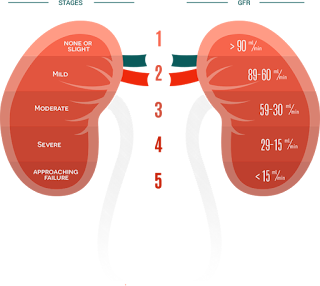What are the three periods of kidney failure?
Renal failure is a pathological state of the renal function or total loss caused by the development of various chronic renal diseases.
Kidney failure can be divided into acute renal failure and chronic kidney failure, which can show different symptoms.
Renal failure should be early found early treatment, is critical to understand the early symptoms of kidney failure, kidney failure, affect the body's system has various clinical manifestations and to lead to chronic renal failure disease types and the basis of the degree of renal failure.
The kidney has powerful compensatory function, the glomerular filtration rate is 50ml/min, the serum creatinine can be normal, the patient can have no symptoms, easy to be neglected by the patient.
When the glomerular filtration rate was above 30ml/min, most patients tended to have no subjective symptoms, or only increased nocturnal urine, weak and lumbar acid, slightly swollen ankle.
Clinically, the symptoms of renal failure can be seen in three periods: oliguria, polyuresis, recovery period.
1. Low urinary duration: in the most critical stage, the internal environment is seriously disturbed.
The patient may have less urine (< 400ml/day) or no urine (< 100ml/day), low specific urine (1.010 ~ 1.020), high urine sodium, hematuria, proteinuria, tube type urine, etc.
Serious patients can appear water intoxication, hyperkalaemia (often to death), metabolic acidosis (can promote the occurrence of hyperkalemia) and nitrogen qualitative hematic disease (progression can appear uremia), endanger the patient lives.
This period lasts for a few days to a few weeks, and the longer it lasts, the worse the prognosis.
2. Polyuria: the amount of urine is gradually increased after the short urine period, and when the daily urine volume exceeds 500ml, it is in the multi-urine period.
Since then, the amount of urine has multiplied daily, and the maximum urine volume is 3,000 to 6000ml per day, or even more than 10000ml.
At the beginning of the multi-urine period, although the amount of urine is increased, the removal rate of the kidneys is still low, and the accumulation of metabolites in vivo still exists.
After about 4 ~ 5 days, the serum urea nitrogen, creatinine and so on increased with the amount of urine, and the symptoms of uremia also improved.
Potassium, sodium, chlorine and other electrolytes can cause electrolyte disturbance or dehydration in the discharge of large amounts of electrolyte from urine. It should be noted that the peak phase of the low urinary cycle may be converted to hypokalemia.
This period lasts 1 ~ 2 weeks.
3, recovery: urine gradually returned to normal, kidney function recover 3 ~ 12 months, the majority of patients renal function can be recovered to normal level, only a minority of patients with chronic renal failure.

评论
发表评论